Five Years of Dust Episodes at the Southern Italy GAW Regional Coastal Mediterranean Observatory: Multisensors and Modeling Analysis
Abstract
1. Introduction
2. Data and Methods
2.1. Site and Instruments
2.1.1. The Experimental Site
2.1.2. The Instrumental Setup
- a periodical full nephelometer calibration was performed using CO2 as span gas;
- a zero calibration was carried out once an hour using internally filtered particle-free air.
2.2. Data
2.2.1. Modeling Products
2.2.2. Satellite Products
2.2.3. Optical Properties
2.3. The Identification of Dust Events: The Method
- dust collection, through impactors or dry deposition with the opportunity to recognize by SEM the presence of dust particles; and
- optical measurements to derive related properties regarding AOD and SAE.
3. Results and Discussion
3.1. General Features
3.2. Climatology of Dust Events and Seasonality
3.3. Large-Scale Atmospheric Patterns
4. Case Study: The Dust Outbreak 23–27 April 2019
4.1. Derived Intensive Parameters
4.2. Synoptic Features
4.3. Satellite and Model Products
5. Conclusive Remarks and Future Works
- SAE parameter with value close to 0.65, shows that the PM coarse fraction at the surface is mixed with fine/coarse due to the influence of the transport of continental aerosol;
- g parameter does not show a significant change, but there is a small increase when we considering the S-E event sector;
- filter images by SEM demonstrate the presence of mixed particles.
Author Contributions
Funding
Acknowledgments
Conflicts of Interest
References
- Textor, C.; Schulz, M.; Guibert, S.; Kinne, S.; Balkanski, Y.; Bauer, S.E.; Berntsen, T.; Berglen, T.F.; Boucher, O.; Chin, M.; et al. Analysis and quantification of the diversities of aerosol life cycles within AeroCom. Atmos. Chem. Phys. 2006, 6, 1777–1813. [Google Scholar] [CrossRef]
- Huneeus, N.; Schulz, M.; Balkanski, Y.; Griesfeller, J.; Prospero, M.J.; Kinne, S.; Bauer, S.; Boucher, O.; Chin, M.; Dentener, F.; et al. Global dust model intercomparison in AeroCom phase I. Atmos. Chem. Phys. 2011, 11, 7781–7816. [Google Scholar] [CrossRef]
- Washington, R.; Todd, M.; Middleton, N.J.; Goudie, A.S. Dust-Storm Source Areas Determined by the Total Ozone Monitoring Spectrometer and Surface Observations. Ann. Assoc. Am. Geogr. 2003, 93, 297–313. [Google Scholar] [CrossRef]
- Prospero, J.M.; Ginoux, P.; Torres, O.; Nicholson, S.E.; Gill, T.E. Environmental characterization of global sources of atmospheric soil dust identified with the NIMBUS 7 Total Ozone Mapping Spectrometer (TOMS) absorbing aerosol product. Rev. Geophys. 2002, 40. [Google Scholar] [CrossRef]
- Papayannis, A.; Balis, D.; Amiridis, V.; Chourdakis, G.; Tsaknakis, G.; Zerefos, C.; Castanho, A.D.A.; Nickovic, S.; Kazadzis, S.; Grabowski, J. Measurements of Saharan dust aerosols over the Eastern Mediterranean using elastic backscatter-Raman lidar, spectrophotometric and satellite observations in the frame of the EARLINET project. Atmos. Chem. Phys. 2005, 5, 2075–2110. [Google Scholar] [CrossRef]
- Israelevich, P.; Ganor, E.; Alpert, P.; Kishcha, P.; Stupp, A. Predominant transport paths of Saharan dust over the Mediterranean Sea to Europe. J. Geophys. Res. 2012, 117, D02205. [Google Scholar] [CrossRef]
- Shao, Y.; Wyrwoll, K.H.; Chappell, A.; Huang, J.; Lin, Z.; Mc-Tainsh, G.H.; Mikami, M.; Tanaka, T.Y.; Wang, X.; Yoon, S. Dust cycle: An emerging core theme in Earth system science. Aeolian Res. 2011, 2, 181–204. [Google Scholar] [CrossRef]
- D’Almeida, G.A. A model for Saharan dust transport. Clim. Appl. Meteorol. 1986, 25, 903–916. [Google Scholar] [CrossRef]
- Prospero, J.M.; Mayol-Bracero, O.L. Understanding the trans- port and impact of African dust on the Caribbean basin. Bull. Am. Meteorol. Soc. 2013, 94, 1329–1337. [Google Scholar] [CrossRef]
- Yu, H.; Chin, M.; Bian, H.; Yuan, T.; Prospero, J.M.; Omar, A.H.; Remer, L.A. Quantification of trans-Atlantic dust transport from seven-year (2007–2013) record of CALIPSO lidar measurements. Emerg. Infect Dis. 2015, 159, 232–249. [Google Scholar] [CrossRef]
- Moulin, C.; Lambert, C.E.; Dayan, U.; Masson, V.; Ramonet, M.; Bousquet, P.; Legrand, M.; Balkanski, Y.J.; Guelle, W.; Marticorena, B.; et al. Satellite climatology of African dust transport in the Mediterranean atmosphere. Geophys. Res. Atmos 1998, 103, 13137–13144. [Google Scholar] [CrossRef]
- Barnaba, F.; Gobbi, G.P. Aerosol seasonal variability over the Mediterranean region and relative impact of maritime, continental and Saharan dust particles over the basin from MODIS data in the year 2001. Atmos. Chem. Phys. 2004, 4, 2367–2391. [Google Scholar] [CrossRef]
- Pey, J.; Querol, X.; Alastuey, A.; Forastiere, F.; Stafoggia, M. African dust outbreaks over the Mediterranean Basin during 2001–2011: PM10 concentrations, phenomenology and trends, and its relation with synoptic and mesoscale meteorology. Atmos. Chem. Phys. 2003, 13, 1395–1410. [Google Scholar] [CrossRef]
- Goudie, A.S.; Middleton, N.J. Saharan dust storms: Nature and consequences. REarth Sci. Rev. 2001, 56, 179–204. [Google Scholar] [CrossRef]
- Engelstaedter, S.; Tegen, I.; Washington, R. North African dust emissions and transport. Earth Sci. Rev. 2006, 79, 73–100. [Google Scholar] [CrossRef]
- Barkan, J.; Kutiel, H.; PAlpert, P.; Kischa, P. The synoptics of dust transportation days from Africa toward Italy and central Europe. J. Geophys. Res.-Atmos. 2005, 110, D07208. [Google Scholar] [CrossRef]
- Dayan, U.; Hefter, J.; Miller, J.; Gutman, G. Dust intrusion events into the Mediterranean basin. J. Appl. Meteor. 1991, 30, 1188–1193. [Google Scholar] [CrossRef]
- Ginoux, P.; Chin, M.; Tegen, I.; Prospero, J.M.; Holben, B.; Dubovik, O.; Lin, S.J. Sources and distributions of dust aerosols simulated with the GOCART model. J. Geophys. Res. 2001, 106, 20255–20273. [Google Scholar] [CrossRef]
- Tsidulko, M.; Krichak, S.O.; Alpert, P.; Kakaliagou, O.; Kallos, G.; Papadopoulos, A. Numerical study of a very intensive eastern mediterranean dust storm, 13–16 March 1998. J. Geophys. Res. 2002, D21, 1–13. [Google Scholar] [CrossRef]
- Rizza, U.; Barnaba, F.; Miglietta, M.M.; Mangia, C.; Di Liberto, L.; Dionisi, D.; Costabile, F.; Grasso, F.; Gobbi, G.P. WRF-Chem model simulations of a dust outbreak over the central Mediterranean and comparison with multi-sensor desert dust observations. Atmos. Chem. Phys. 2017, 17, 93–115. [Google Scholar] [CrossRef]
- Gobbi, G.P.; Barnaba, F.; Di Liberto, L.; Bolignano, A.; Lucarelli, F.; Nava, S.; Perrino, C.; Pietrodangelo, A.; Basart, S.; Costabile, F.; et al. An inclusive view of Saharan dust advections to Italy and the Central Mediterranean. Atmos. Environ. 2019, 9, 242–256. [Google Scholar] [CrossRef]
- Moulin, C.; Dulac, F.; Lambert, C.E.; Chazette, P.; Jankowiak, I.; Chatenet, B.; Lavenu, F. Long-term daily monitoring of Saharan dust load over ocean using Meteosat ISCCP-B2 data, 2, Accuracy of the method and validation using sunphotometer measurements. Geophys. Res. 1997, 102, 959–969. [Google Scholar] [CrossRef]
- Alpert, P.F.; Ganor, E. Sahara mineral dust mineral dust measurements from TOMS:Comparison to surface observations over Middle East for the extreme duststorm, 14–17 March 1998. J. Geophys. Res. 2001, 106, 275–286. [Google Scholar] [CrossRef]
- Israelevich, P.; Levin, Z.; Joseph, J.H.; Ganor, E. Desert aerosol transport in the Mediterranean region as inferred from the TOMS aerosol index. J. Geophys. Res. 2001, 107, 4572. [Google Scholar] [CrossRef]
- Rodrıguez, S.; Querol, X.; Alastuey, A.; Kallos, G.; Kakaliagou, O. Saharan dust contribution to PM10 and TSP levels in Southern and Eastern Spain. Atmos. Environ. 2001, 35, 2433–2447. [Google Scholar] [CrossRef]
- Meloni, D.; Di Sarra, A.; Biavati, G.; DeLuisi, J.J.; Monteleone, F.; Pace, G.; Piacentino, S.; Sferlazzo, D.M. Seasonal behavior of Saharan dust events at the Mediterranean island of Lampedusa in the period 1999–2005. Atmos. Environ. 2007, 41, 3041–3056. [Google Scholar] [CrossRef]
- Marticorena, B.; Chatenet, B.; Rajot, J.L.; Coulibaly, M.; Diallo, A.; Maman, A.; NDiaye, T.; Zakou, A. Temporal variability of mineral dust concentrations over West Africa: Analyses of a pluriannual monitoring from the AMMA Sahelian Dust Transect. Atmos. Chem. Phys. 2010, 10, 8899–8915. [Google Scholar] [CrossRef]
- Pereira, S.N.; Wagner, F.; Silva, A.M. Seven year of measurements of aerosol scattering properties, near the surface, in the southwestern Iberia Peninsula. Atmos. Chem. Phys. 2011, 11, 17–29. [Google Scholar] [CrossRef]
- Perrone, M.R.; Romano, S.; Orza, J.A.G. Particle optical properties at a Central Mediterranean site: Impact of advection routes and local meteorology. Atmos. Res. 2014, 145–146, 152–167. [Google Scholar] [CrossRef]
- Kaly, F.; Marticoréna, B.; Chatenet, B.; Rajot, J.L.; Janicot, S.; Niang, A.; Yahi, H.; Thiria, S.; Maman, A.; Zakou, A.; et al. Variability of mineral dust concentrations over West Africa monitored by the Sahelian Dust Transect. Atmos. Res. 2015, 164–165, 226–241. [Google Scholar] [CrossRef]
- Pandolfi, M.; Alados-Arboledas, L.; Alastuey, A.; Andrade, M.; Angelov, C.; Backman, J.; Baltensperger, U.; Bonasoni, P.; Bukowiecki, N.; Coen, M.C. A European aerosol phenomenology—6: Scattering properties of atmospheric aerosol particles from 28 ACTRIS sites. Atmos. Chem. Phys. 2018, 18, 7877–7911. [Google Scholar] [CrossRef]
- Donateo, A.; Lo Feudo, T.; Marinoni, A.; Calidonna, C.R.; Contini, D.; Bonasoni, P. Long-term observations of aerosol optical properties at three GAW regional sites in the Central Mediterranean. Atmos. Res. 2020, 241, 104976. [Google Scholar] [CrossRef]
- Perrone, M.R.; Romano, S.; Genga, A.; Paladini, F. Integration of optical and chemical parameters to improve the particulate matter characterization. Atmos. Res. 2018, 205, 93–106. [Google Scholar] [CrossRef]
- Conte, M.; Merico, E.; Cesari, D.; Dinoi, A.; Grasso, F.M.; Donateo, A.; Guascito, M.R.; Contini, D. Long-term characterisation of African dust advection in south-eastern Italy: Influence on fine and coarse particle concentrations, size distributions, and carbon content. Atmos. Res. 2019, 233, 104690. [Google Scholar] [CrossRef]
- Hamonou, E.; Chazette, P.; Balis, D.; Dulac, F.; Schneider, X.; Galani, E.; Ancellet, G.; Papayannis, A. Characterization of the vertical structure of Saharan dust export to the Mediterranean basin. J. Geophys. Res. 1999, 104, 22257–22270. [Google Scholar] [CrossRef]
- Gobbi, G.P.; Barnaba, F.; Giorgi, R.; Santacasa, A. Altitude-resolved properties of a Saharan Dust event over the Mediterranean. Atmos. Environ. 2000, 34, 5119–5127. [Google Scholar] [CrossRef]
- Ansmann, A.; Bösenberg, J.; Chaikovsky, A.; Comerón, A.; Eckhardt, S.; Eixmann, R.; Freudenthaler, V.; Ginoux, P.; Komguem, L.; Linné, H.; et al. Long-range transport of Saharan dust to northern Europe: The 11–16 October 2001 outbreak observed with EARLINET. J. Geophys. Res. 2003, 108, 4783. [Google Scholar] [CrossRef]
- Müller, T.; Laborde, M.; Kassell, G.; Wiedensohler, A. Design and performance of a three-wavelength LED-based total scatter and backscatter integrating nephelometer. Atmos. Meas. Tech. 2011, 4, 1291–1303. [Google Scholar] [CrossRef]
- Federico, S.; Pasqualoni, L.; Sempreviva, A.M.; De Leo, L.; Avolio, E.; Calidonna, C.R.; Bellecci, C. The seasonal characteristics of the breeze circulation at a coastal Mediterranean site in South Italy. Adv. Sci. Res. 2010, 4, 47–56. [Google Scholar] [CrossRef]
- Anderson, T.L.; Covert, D.S.; Marshall, S.F.; Laucks, M.L.; Charlson, R.J.; Waggoner, A.P.; Ogren, J.A.; Caldow, R.; Holm, R.L.; Quant, F.R.; et al. Performance characteristics of a high-sensitivity, three-wavelength, total scatter/backscatter nephelometer. J. Atmos. Ocean. Technol. 1996, 13, 967–986. [Google Scholar] [CrossRef]
- Petzold, A.; Schloesser, H.; Sheridan, P.J.; Arnott, P.; Ogren, J.A.; Virkkula, A. Evaluation of multiangle absorption photometry for measuring aerosol light absorption. Aerosol Sci. Technol. 2005, 39, 40–51. [Google Scholar] [CrossRef]
- Petzold, A.; Schönlinner, M. A Multi-angle absorption photometry—A new method for the measurement of aerosol light absorption and atmospheric black carbon. Aerosol Sci. 2004, 35, 421–441. [Google Scholar] [CrossRef]
- WMO/GAW Standard Operating Procedures for In-Situ Measurements of Aerosol Mass Concentration, Light Scattering and Light Absorption. Edited by John A. Ogren. World Meteorological Organization. 2011. Available online: https://wmo-gaw-wcc-aerosol-physics.org/files/gaw-200.pdf (accessed on 27 January 2020).
- OPC Technical Specification, Fai Instruments. Available online: http://fai-instruments.net/wp-content/uploads/2016/02/de\protect\discretionary{\char\hyphenchar\font}{}{}pliant_OPC_multi\protect\discretionary{\char\hyphenchar\font}{}{}canale_Mag\protect\discretionary{\char\hyphenchar\font}{}{}2010-1.pdf (accessed on 27 January 2020).
- SWAM Technical Specification, Fai Instruments. Available online: http://fai-instruments.net/wp-content/uploads/2016/02/TECHNICAL-SPECIFICATIONS-SW-DC-1.pdf (accessed on 27 January 2020).
- CIMEL Data Sheet, CIMEL. Available online: https://www.cimel.fr/wp-content/uploads/2019/06/Brochure-CE318-T-1.pdf (accessed on 21 April 2020).
- Holben, B.N.; Eck, T.F.; Slutsker, I.; Tanre, D.; Buis, J.P.; Setzer, A.; Vermote, E.; Reagan, J.A.; Kaufman, Y.; Nakajima, T.; et al. AERONET—A federated instrument network and data archive for aerosol characterization. Remote Sens. Environ. 1998, 66, 1–16. [Google Scholar] [CrossRef]
- Dubovik, O.; King, M.D. A flexible inversion algorithm for retrieval of aerosol optical properties from Sun and sky radiance measurements. Geophys. Res. Atmos. 2000, 105, 20673–20696. [Google Scholar] [CrossRef]
- Eck, T.F.; BNHolben, J.S.; Smirnov, A.; O’Neill, N.T.; Slutsker, I.; Kinne, S. Wavelength dependence of optical depth of biomass burning, urban, and dust aerosols. Geophys. Res. 1999, 104, 31333–31349. [Google Scholar] [CrossRef]
- Dubovik, O.; Holben, B.; Eck, T.F.; Smirnov, A.; Kaufman, Y.J.; King, M.D.; Tanré, D.; Slutsker, I. Variability of absorption and optical properties of key aerosol types observed in worldwide locations. J. Atmos. Sci. 2002, 59, 590–608. [Google Scholar] [CrossRef]
- Copernicus Climate Change Service (C3S) (2017): ERA5: Fifth Generation of ECMWF Atmospheric Reanalyses of the Global Climate. Copernicus Climate Change Service Climate Data Store (CDS). Available online: https://cds.climate.copernicus.eu/cdsapp#!/home (accessed on 3 April 2020).
- Benedetti, A.; Morcrette, J.J.; Boucher, O.; Dethof, A.; Engelen, R.J.; Fisher, M.; Flentje, H.; Huneeus, N.; Jones, L.; Kaiser, J.W.; et al. Aerosol analysis and forecast in the European Centre for Medium- Range Weather Forecasts Integrated Forecast System. Part 2: Data assimilation. J. Geophys. Res. Atmos. 2009, 114, D13205. [Google Scholar] [CrossRef]
- Morcrette, J.-J.; Boucher, O.; Jones, L.; Salmond, D.; Bechtold, P.; Beljaars, A.; Benedetti, A.; Bonert, A.; Kaiser, J.W.; Razinger, M.; et al. Aerosol analysis and forecast in the European Centre for Medium-Range Weather Forecasts Integrated Forecast System. Part 1: Forward modelling. J. Geophys. Res. Atmos. 2009, 114, D06206. [Google Scholar] [CrossRef]
- Stein, A.F.; Draxler, R.R.; Rolph, G.D.; Stunder, B.J.B.; Cohen, M.D.; Ngan, F. NOAA’s HYSPLIT atmospheric transport and dispersion modeling system. Bull. Am. Meteorol. Soc. 2015, 96, 2059–2077. [Google Scholar] [CrossRef]
- Rolph, G.; Stein, A.; Stunder, B. Real-time Environmental Applications and Display System: Ready. Environ. Mod. Soft. 2017, 95, 210–228. [Google Scholar] [CrossRef]
- Levy, R.C.; Mattoo, S.; Munchak, L.A.; Remer, L.A.; Sayer, A.M.; Patadia, F.; Hsu, N.C. The Collection 6 MODIS aerosol products over land and ocean. Atmos. Meas. Tech. 2013, 6, 2989–3034. [Google Scholar] [CrossRef]
- Wei, J.; Peng, Y.; Guo, J.; Sun, L. Performance of MODIS Collection 6.1 Level 3 aerosol products in spatial-temporal variations over land. Atmos. Environ. 2019, 206, 30–44. [Google Scholar] [CrossRef]
- Wei, J.; Li, Z.; Peng, Y.; Sun, L. MODIS Collection 6.1 aerosol optical depth products over land and ocean: Validation and comparison. Atmos. Environ. 2019, 201, 428–440. [Google Scholar] [CrossRef]
- Wei, J.; Li, Z.; Sun, L.; Peng, Y.; Wang, L. Improved merge schemes for MODIS collection 6.1 dark target and deep blue combined aerosol products. Atmos. Environ. 2019, 202, 315–327. [Google Scholar] [CrossRef]
- Zhang, G.; Wu, J.; Fan, W.; Yang, Q.; Zhao, D. Review of aerosol optical depth retrieval using visibility data. Earth Sci. Rev. 2020, 200, 102986. [Google Scholar] [CrossRef]
- Anderson, T.L.; Ogren, J.A. Determining Aerosol Radiative Properties Using the TSI 3563 Integrating Nephelometer. Aerosol. Sci. Technol. 1998, 29, 57–69. [Google Scholar] [CrossRef]
- Bond, T.C.; Covert, D.S.; Müller, T. Truncation and Angular- Scattering Corrections for Absorbing Aerosol in the TSI 3563 Nephelometer. Aerosol. Sci. Technol. 2009, 43, 866–871. [Google Scholar] [CrossRef]
- Costabile, F.; Barnaba, F.; Angelini, F.; Gobbi, G.P. Identification of key aerosol populations through their size and composition resolved spectral scattering and absorption. Atmos. Chem. Phys. 2013, 13, 866–871. [Google Scholar] [CrossRef]
- Bryant, C.; Eleftheriadis, K.; Smolik, J.; Zdimal, V.; Mihalopoulos, N.; Colbeck, I. Optical properties of aerosols over the eastern Mediterranean. Atmos. Environ. 2006, 40, 6229–6244. [Google Scholar] [CrossRef]
- Andrews, E.; Sheridan, P.J.; Fiebig, M.; McComiskey, A.; Ogren, J.A.; Arnott, P.; Covert, D.; Elleman, R.; Gasparini, R.; Collins, D.; et al. Comparison of methods for deriving aerosol asymmetry parameter. J. Atmos. Res. 2006, 111, D05S04. [Google Scholar] [CrossRef]
- Schuster, G.L.; Dubovik, O.; Holben, B.N. Angstrom exponent and bimodal aerosol size distributions. J. Geophys. Res. 2006, 111, D07207. [Google Scholar] [CrossRef]
- Virkkula, A.; Backman, J.; Aalto, P.P.; Hulkkonen, M.; Riuttanen, L.; Nieminen, T.; dalMaso, M.; Sogacheva, L.; de Leeuw, G.; Kulmala, M. Seasonal cycle, size dependencies, and source analyses of aerosol optical properties at the SMEARII measurement station in Hyytiälä, Finland. Atmos. Chem. Phys. 2011, 11, 4445–4468. [Google Scholar] [CrossRef]
- Petzold, A.; Kramer, H.; Schönlinner, M. Continuous Measurement of Atmospheric Black Carbon Using a Multi-angle Absorption Photometer. Environ. Sci. Pollut. Res. 2002, 4, 78–82. [Google Scholar]
- Donateo, A.; Lo Feudo, T.; Marinoni, A.; Dinoi, A.; Avolio, E.; Merico, E.; Calidonna, C.R.; Contini, D.; Bonasoni, P. Characterization of In Situ Aerosol Optical Properties at Three Observatories in the Central Mediterranean. Atmosphere 2018, 9, 369. [Google Scholar] [CrossRef]
- Meloni, D.; di Sarra, A.; Pace, G.; Monteleone, F. Optical properties of aerosol over the Central Mediterranean. 2. Determination of single scattering albedo at two wavelengths for different aerosol types. Atmos. Chem. Phys. 2006, 6, 715–727. [Google Scholar] [CrossRef]
- Pace, G.; di Sarra, A.; Meloni, C.; Piacentino, S.; Chamard, P. Aerosol optical properties at Lampedusa (Central Mediterranean). Influence of transport and identification of different aerosol types. Atmos. Chem. Phys. 2006, 6, 697–713. [Google Scholar] [CrossRef]
- Pederzoli, A.; Mircea, M.; Finardi, S.; di Sarra, A.; Zaninia, G. Quantification of Saharan dust contribution to PM10 concentrations over Italy during 2003–2005. Atmos. Environ. 2010, 44, 4181–4190. [Google Scholar] [CrossRef]
- Dinoi, A.; Donateo, A.; Conte, M.; Contini, D.; Belosi, F. Comparison of atmospheric particle concentration measurements using different optical detectors: Potentiality and limits for air quality applications. Meas. J. Int. Meas. Conf. 2017, 106, 274–282. [Google Scholar] [CrossRef]
- Sellitto, P.; Zanetel, C.; di Sarra, A.; Salerno, G.; Tapparo, A.; Meloni, D.; Pace, G.; Caltabiano, T.; Briole, P.; Legras, B. The impact of Mount Etna sulfur emissions on the atmospheric composition and aerosol properties in the central Mediterranean: A statistical analysis over the period 2000–2013 based on observations and Lagrangian modelling. Atmos. Environ 2017, 148, 77–88. [Google Scholar] [CrossRef]
- Gullì, D.; Avolio, E.; Calidonna, C.R.; LoFeudo, T.; Torcasio, R.C.; Sempreviva, A.M. Two years of wind-lidar measurements at an Italian Mediterranean Coastal Site. Energy Procedia 2017, 125, 214–220. [Google Scholar] [CrossRef]
- Pandolfi, M.; Cusack, M.; Alastuey, A.; Querol, X. Variability of aerosol optical properties in the Western Mediterranean Basin. Atmos. Chem. Phys. 2011, 11, 8189–8203. [Google Scholar] [CrossRef]
- Esteve, A.R.; Ogren, J.A.; Sheridan, P.J.; Andrews, E.; Holben, B.N.; Utrillas, M.P. Sources of discrepancy between aerosol optical depth obtained from AERONET and in-situ aircraft profiles. Atmos. Chem. Phys. 2012, 12, 2987–3003. [Google Scholar] [CrossRef]
- Chomette, O.; Legrand, M.; Marticorena, B. Determination of the wind speed threshold for the emission of desert dust using satellite remote sensing in the thermal infrared. J. Geophys. Res. Atmos. 1999, 104, 31207–31215. [Google Scholar] [CrossRef]
- Ealo, M.; Alastuey, A.; Ripoll, A.; Pérez, N.; Minguillon, M.C.; Querol, X.; Pandolfi, M. Detection of Saharan dust and biomass burning events using near-real-time intensive aerosol optical properties in the north-western Mediterranean. Atmos. Chem. Phys. 2016, 16, 12567–12586. [Google Scholar] [CrossRef]
- Guerzoni, S.; Molinaroli, E.; Chester, R. Saharan dust inputs to the W. Mediterranean Sea: Depositional patterns, geochemistry and sedimentological implications. Deep Sea Res. II 1997, 44, 331–654. [Google Scholar] [CrossRef]
- Matassoni, L.; Pratesi, G.; Centioli, D.; Cadoni, F.; Lucarelli, F.; Nava, S.; Malesani, P. Saharan dust contribution to PM10, PM2.5 and PM1 in urban and suburban areas of Rome: A comparison between single-particle SEM-EDS analysis and whole-sample PIXE analysis. J. Environ. Monit. 2011, 13, 732. [Google Scholar] [CrossRef]
- Molinaroli, E.; Guerzoni, S.; Rampazzo, G. Contribution of Saharan dust to the central Mediterranean basin. Processes controlling the composition of clastic sediments. Geol. Soc. Am. 1993, 1SP284, 303–312. [Google Scholar]
- Blanco, A.; De Tomasi, F.; Filippo, E.; Manno, D.; Perrone, M.R.; Serra, R.; Tafuro, A.M.; Tepore, A. Characterization of African dustover southern Italy. Atmos. Chem. Phys. Disc. 2003, 13, 4633–4670. [Google Scholar] [CrossRef]
- Falkovich, A.H.; Ganor, E.; Levin, E.; Formenti, P.; Rudich, Y. Chemical and mineralogical analysis of individual mineral dust particles. J. Geophys. Res. 2001, 106, 29–36. [Google Scholar] [CrossRef]
- Reid, J.S.; Jonsson, H.H.; Maring, H.B.; Smirnov, A.; Savoie, D.L.; Cliff, S.S.; Reid, E.A.; Livingston, J.M.; Meier, M.M.; Dubovik, O.; et al. Comparison of size and morphological measurements of coarse mode dust particles from Africa. J. Geophys. Res. 2003, 108. [Google Scholar] [CrossRef]
- Shi, Z.; Shao, L.; Jones, T.P.; Lu, S. Microscopy and mineralogy of airborne particles collected during severe dust storm episodes in Beijing. China. Geophys. Res. 2005, 110, D01303. [Google Scholar] [CrossRef]


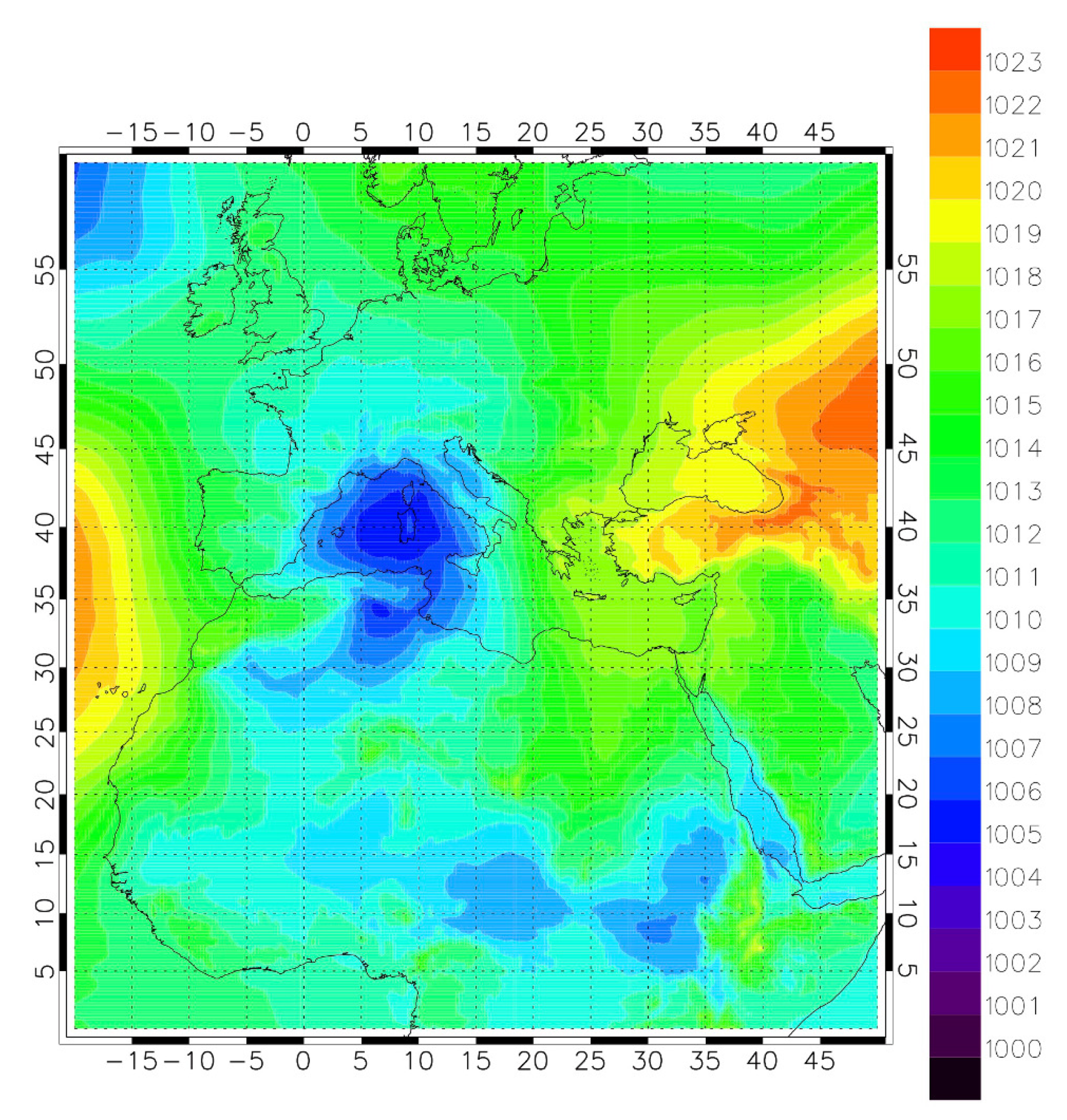
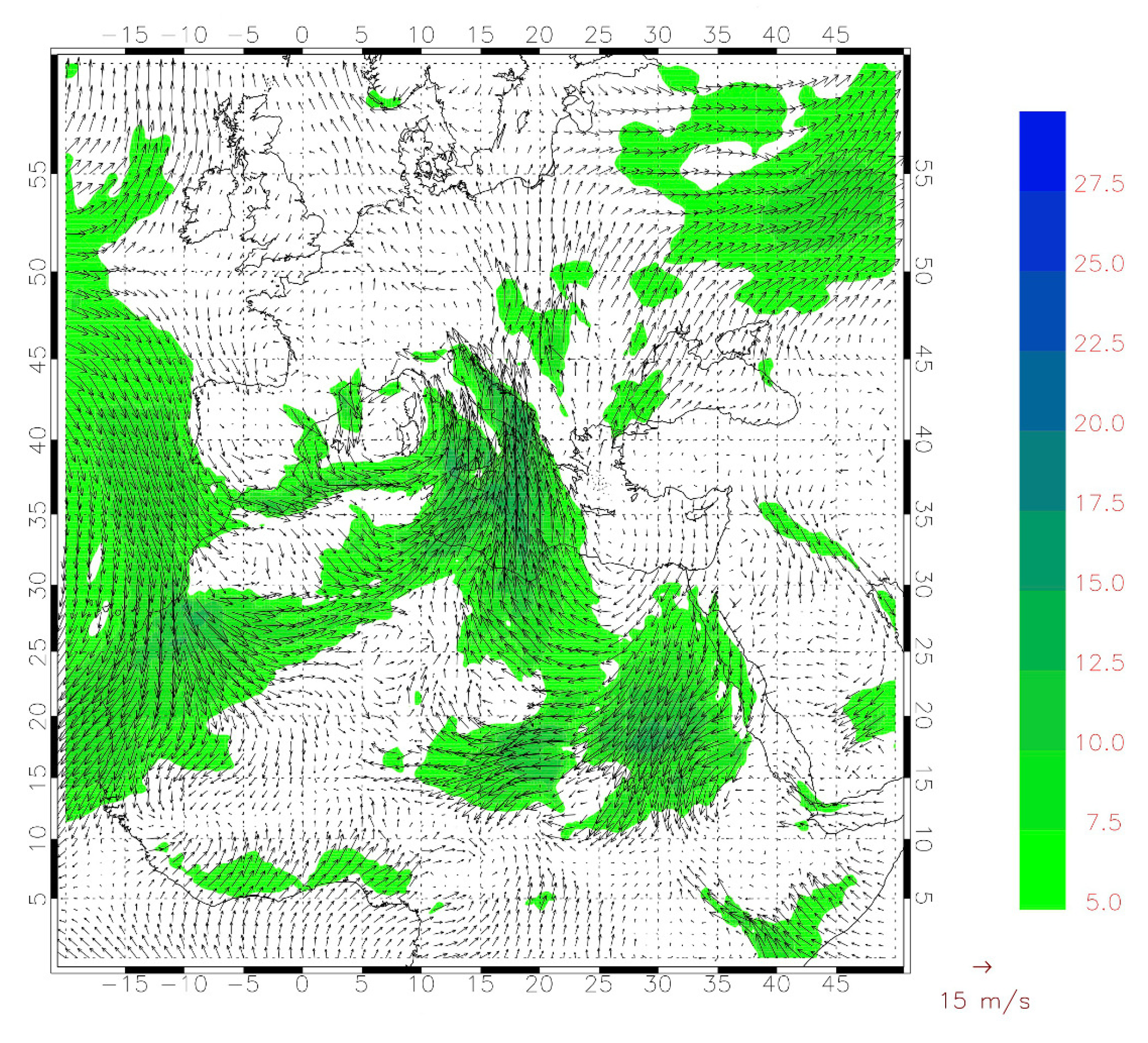
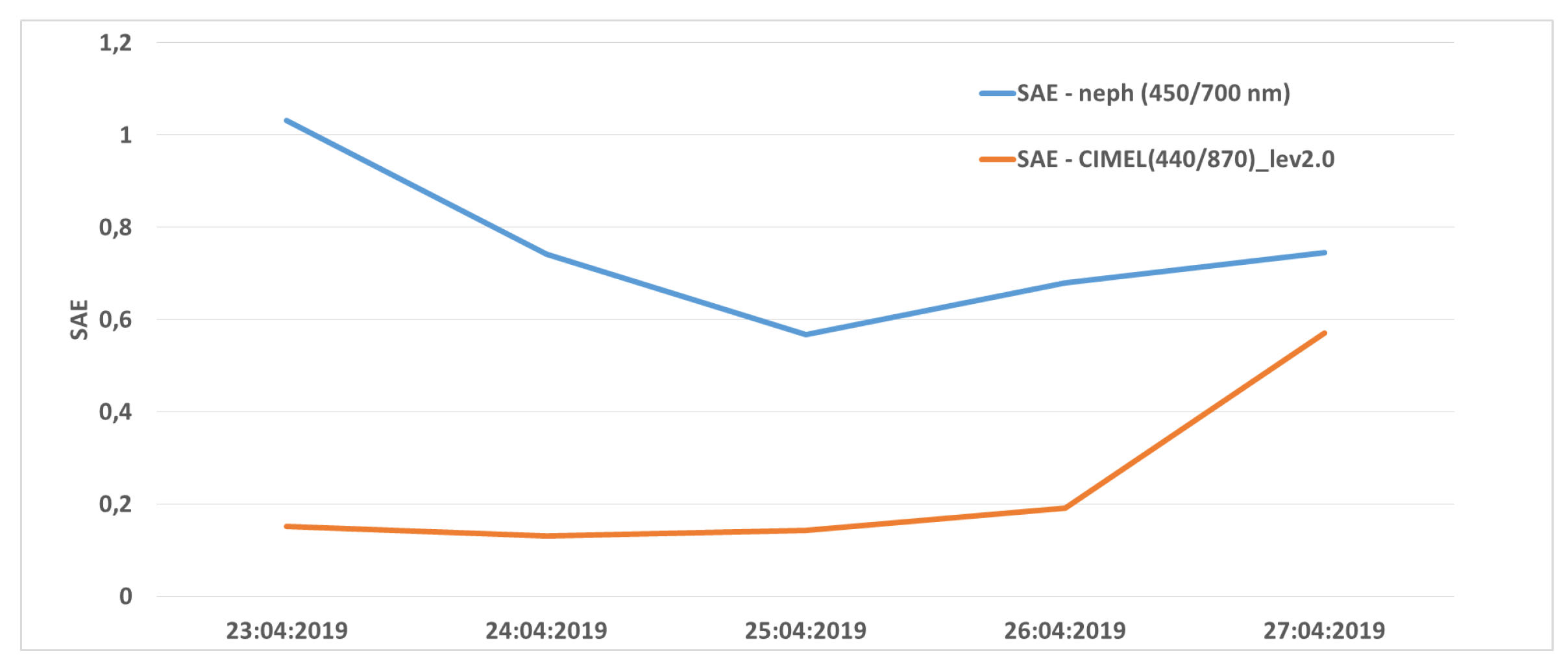


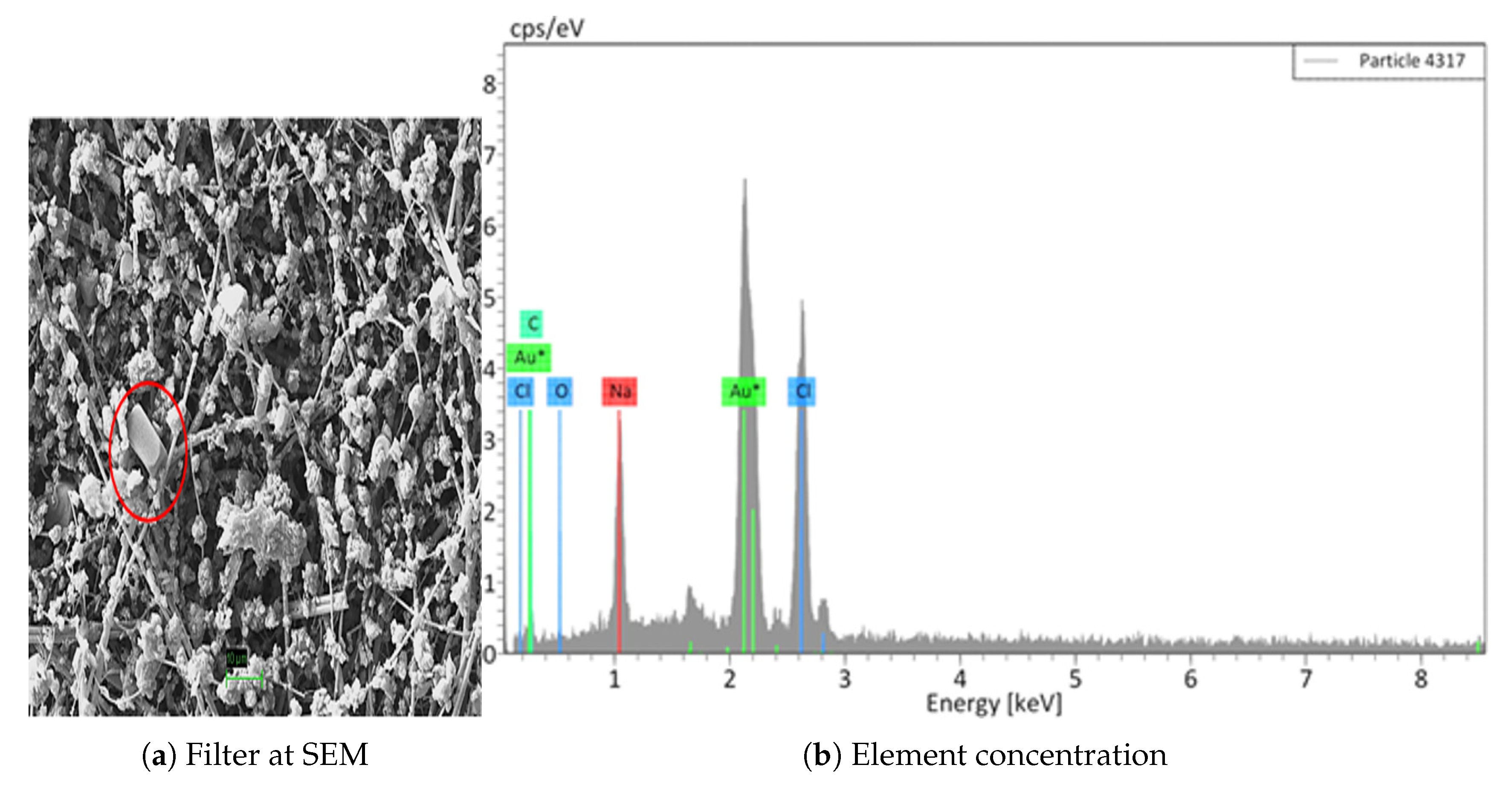



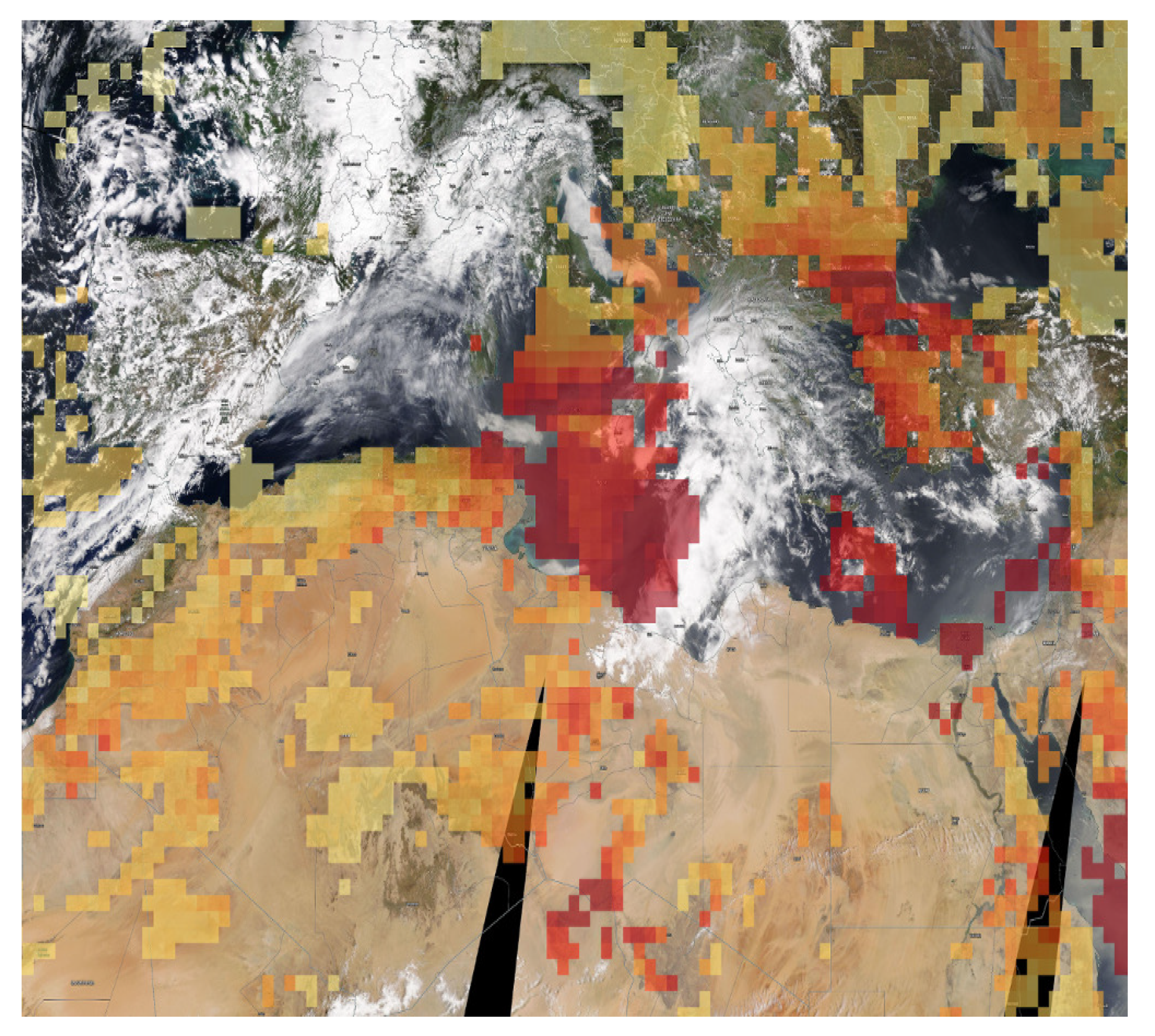
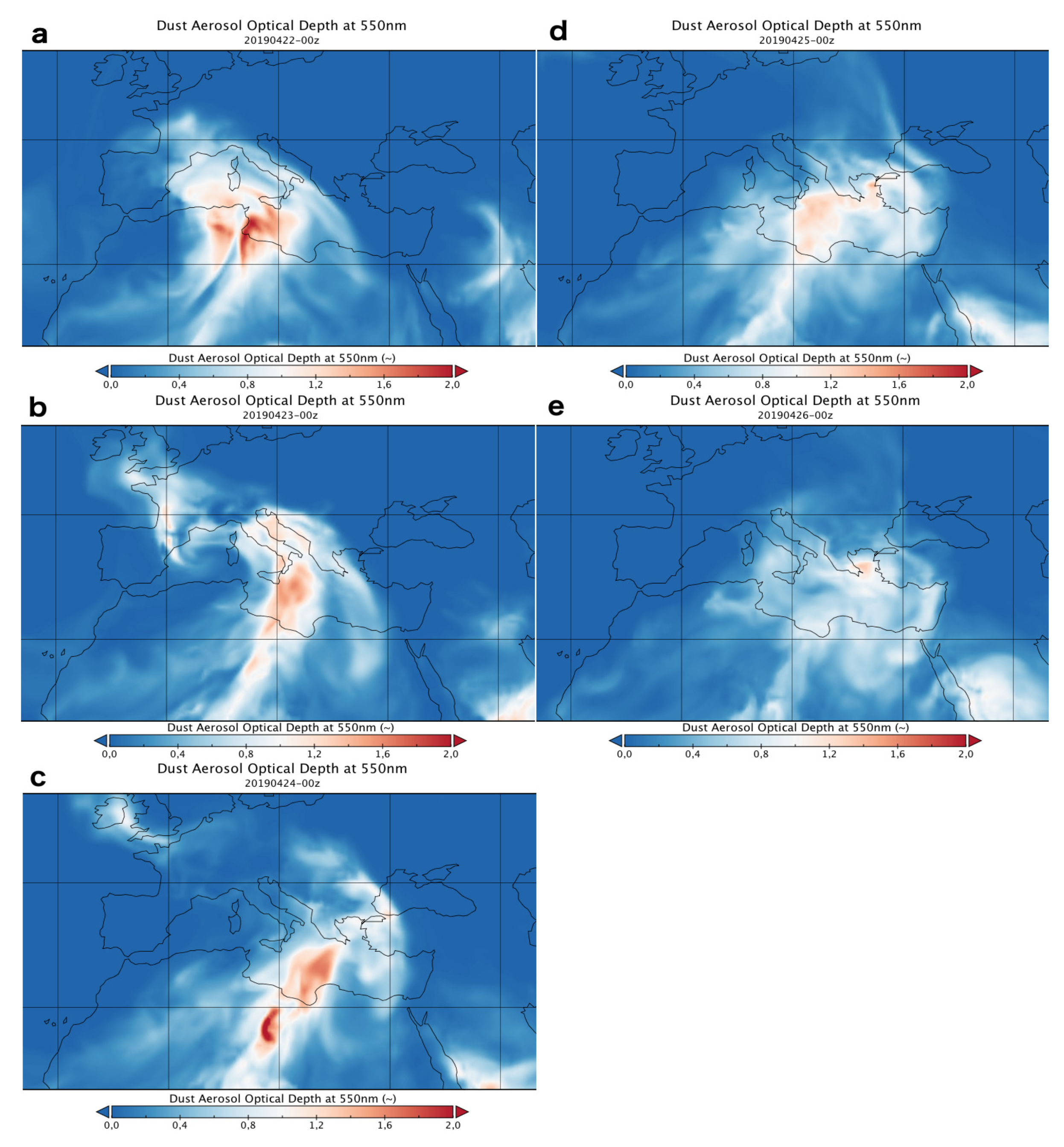


| eBC (g/m) | |
|---|---|
| daily mean | 0.51 |
| median | 0.81 |
| std. dev | 0.31 |
| max | 1.60 |
| perc 10 | 0.17 |
| perc 90 | 0.81 |
| Dust Events Starting | Event Duration (Days) | Cold Season | Warm Season | |
|---|---|---|---|---|
| 5 February 2015 | 3 | X | ||
| 25 March 2015 | 3 | X | ||
| 15 February 2016 | 3 | X | ||
| 13 April 2016 | 3 | X | ||
| 17 June 2016 | 1 | X | ||
| 25 February 2017 | 3 | X | ||
| 27 April 2017 | 3 | X | ||
| 12 May 2017 | 3 | X | ||
| 7 February 2018 | 3 | X | ||
| 15 April 2018 | 9 | X | ||
| 19 October 2018 | 2 | X | ||
| 29 October 2018 | 2 | X | ||
| 23 April 2019 | 5 | X | ||
| 12 May 2019 | 3 | X | ||
| 19 December 2019 | 6 | X | ||
| Total | 15 | 52 | 8 | 7 |
| Cold Season (g/m) | Warm Season (g/m) | |
|---|---|---|
| mean | 29.09 | 31.60 |
| median | 22.20 | 27.45 |
| std.dev | 12.53 | 10.34 |
| min | 20.8 | 20.6 |
| max | 60.04 | 50.04 |
| Year | 2015 | 2016 | 2017 | 2018 | 2019 | Total /Mean % |
|---|---|---|---|---|---|---|
| SWAM/days | 283 | 282 | 267 | 191 | 218 | 1241 |
| SWAM/% | 77.53 | 77.05 | 73.15 | 52.33 | 59.73 | 67.96 |
| OPC/hours | 7658 | 7584 | 4506 | 4438 | 3107 | 27293 |
| OPC/% | 87.42 | 86.34 | 51.44 | 50.66 | 35.47 | 62.27 |
| MAAP/hours | 7287 | 7293 | 7569 | 8657 | 8623 | 39429 |
| MAAP/% | 83.18 | 83.03 | 86.40 | 98.82 | 98.44 | 89.98 |
| NEPH/hours | 4568 | 4235 | 4874 | 4050 | 3902 | 21629 |
| NEPH/% | 52.15 | 48.21 | 55.64 | 46.23 | 44.54 | 49.35 |
| Mean | Median | Max | Min | perc10 | perc90 | Std err | |
|---|---|---|---|---|---|---|---|
| (Mm) | 44.44 | 32.87 | 805.55 | 0.51 | 17.74 | 114.95 | 0.7 |
| (Mm) | 32.08 | 23.22 | 660.30 | 0.31 | 13.38 | 82.34 | 0.52 |
| ( Mm ) | 14.99 | 9.48 | 308.26 | 0.36 | 3.59 | 38.72 | 0.23 |
| (Mm) | 5.55 | 4.22 | 88.47 | 0.003 | 2.42 | 11.50 | 0.07 |
| (Mm) | 4.41 | 3.40 | 63.97 | 0.02 | 2.02 | 9.00 | 0.05 |
| (Mm) | 2.40 | 1.61 | 70.95 | 0.07 | 0.59 | 6.58 | 0.03 |
| SAE | 1.84 | 1.94 | 3.75 | −1.45 | 1.12 | 2.93 | 0.01 |
| SAE | 2.07 | 1.96 | 5.23 | −3.23 | 1.03 | 3.65 | 0.01 |
| SAE | 1.56 | 1.85 | 4.05 | −2.68 | 1.04 | 2.16 | 0.01 |
| g | 0.570 | 0.490 | 0.990 | −1.060 | 0.434 | 0.860 | 0.002 |
| g | 0.530 | 0.540 | 0.990 | −2.900 | 0.499 | 0.60 | 0.002 |
| g | 0.560 | 0.570 | 0.980 | −2.900 | 0.531 | 0.644 | 0.002 |
| eBC (g/m) | 0.643 | 0.586 | 11.266 | 0.035 | 0.249 | 1.096 | 0.001 |
| PM coarse (g/m) | 10.69 | 9.51 | 60.4 | 2.5 | 7.9 | 19.9 | 0.02 |
| # Dust Events | Mean | Median | std.dev | std.err |
|---|---|---|---|---|
| All data | 15 | 15 | 15 | 15 |
| (Mm) | 42.95 | 40.49 | 22.53 | 0.64 |
| (Mm) | 40.99 | 38.49 | 22.16 | 0.63 |
| (Mm) | 26.73 | 23.57 | 17.58 | 0.50 |
| (Mm) | 5.31 | 4.76 | 3.37 | 0.09 |
| (Mm) | 5.12 | 4.34 | 3.02 | 0.09 |
| (Mm) | 3.31 | 2.87 | 2.30 | 0.07 |
| SAE | 0.614 | 0.633 | 0.192 | 0.005 |
| SAE | 0.822 | 0.652 | 0.435 | 0.012 |
| SAE | 0.347 | 0.373 | 0.414 | 0.012 |
| g | 0.683 | 0.705 | 0.101 | 0.002 |
| g | 0.590 | 0.586 | 0.055 | 0.001 |
| g | 0.594 | 0.572 | 0.093 | 0.002 |
| Cold Season ONDJFM Events | Mean | Median | std.dev | std.err |
|---|---|---|---|---|
| All data | 8 | 8 | 8 | 8 |
| (Mm) | 41.36 | 37.45 | 24.81 | 1.65 |
| (Mm) | 40.24 | 33.62 | 24.96 | 1.67 |
| (Mm) | 25.23 | 20.70 | 19.29 | 1.29 |
| (Mm) | 5.56 | 4.76 | 3.35 | 0.22 |
| (Mm) | 5.16 | 4.34 | 3.02 | 0.21 |
| (Mm) | 3.25 | 2.67 | 2.61 | 0.17 |
| SAE | 0.557 | 0.621 | 0.169 | 0.011 |
| SAE | 0.875 | 0.955 | 0.446 | 0.030 |
| SAE | 0.174 | 0.179 | 0.348 | 0.023 |
| g | 0.677 | 0.671 | 0.109 | 0.007 |
| g | 0.589 | 0.592 | 0.033 | 0.002 |
| g | 0.572 | 0.571 | 0.033 | 0.002 |
| Warm Season AMJJAS Events | Mean | Median | std.dev | std.err |
|---|---|---|---|---|
| All data | 7 | 7 | 7 | 7 |
| (Mm) | 44.92 | 41.81 | 21.49 | 1.43 |
| (Mm) | 41.92 | 40.61 | 20.52 | 1.37 |
| (Mm) | 29.34 | 27.86 | 15.78 | 1.05 |
| (Mm) | 4.71 | 2.56 | 3.49 | 0.23 |
| (Mm) | 4.95 | 3.08 | 2.85 | 0.19 |
| (Mm) | 3.51 | 3.16 | 0.965 | 0.06 |
| SAE | 0.669 | 0.660 | 0.203 | 0.013 |
| SAE | 0.721 | 0.561 | 0.417 | 0.028 |
| SAE | 0.566 | 0.507 | 0.417 | 0.028 |
| g | 0.690 | 0.716 | 0.089 | 0.006 |
| g | 0.596 | 0.583 | 0.076 | 0.005 |
| g | 0.622 | 0.578 | 0.134 | 0.009 |
| Mean (S-W Wind Direction Event) | Mean (S-E Wind Direction Event) | |
|---|---|---|
| # events | 6 | 9 |
| (Mm) | 43.343 | 47.32 |
| (Mm) | 42.99 | 44.15 |
| (Mm) | 27.96 | 31.24 |
| (Mm) | 5.83 | 5.72 |
| (Mm) | 5.62 | 5.54 |
| (Mm) | 3.87 | 3.83 |
| SAE | 0.428 | 0.653 |
| SAE | 0.620 | 0.758 |
| SAE | 0.197 | 0.499 |
| g | 0.614 | 0.690 |
| g | 0.580 | 0.594 |
| g | 0.579 | 0.603 |
| Year/ PM (g/m) | Mean | Min | Max |
|---|---|---|---|
| 2015 | 10.41 | 2.50 | 24.30 |
| 2016 | 10.12 | 4.40 | 46.10 |
| 2017 | 10.54 | 5.70 | 35.50 |
| 2018 | 11.62 | 5.70 | 60.40 |
| 2019 | 11.14 | 3.60 | 50.40 |
| Saharan Dust Event | PM Mass Mean (g/m) | Al/Si Ratio |
|---|---|---|
| 25 to 28 February 17 | 27 | 0.50 |
| 14 to 17 April 18 | 43.7 | 0.57 |
| 25 April 19 | 50.4 | 0.39 |
© 2020 by the authors. Licensee MDPI, Basel, Switzerland. This article is an open access article distributed under the terms and conditions of the Creative Commons Attribution (CC BY) license (http://creativecommons.org/licenses/by/4.0/).
Share and Cite
Calidonna, C.R.; Avolio, E.; Gullì, D.; Ammoscato, I.; De Pino, M.; Donateo, A.; Lo Feudo, T. Five Years of Dust Episodes at the Southern Italy GAW Regional Coastal Mediterranean Observatory: Multisensors and Modeling Analysis. Atmosphere 2020, 11, 456. https://doi.org/10.3390/atmos11050456
Calidonna CR, Avolio E, Gullì D, Ammoscato I, De Pino M, Donateo A, Lo Feudo T. Five Years of Dust Episodes at the Southern Italy GAW Regional Coastal Mediterranean Observatory: Multisensors and Modeling Analysis. Atmosphere. 2020; 11(5):456. https://doi.org/10.3390/atmos11050456
Chicago/Turabian StyleCalidonna, Claudia Roberta, Elenio Avolio, Daniel Gullì, Ivano Ammoscato, Mariafrancesca De Pino, Antonio Donateo, and Teresa Lo Feudo. 2020. "Five Years of Dust Episodes at the Southern Italy GAW Regional Coastal Mediterranean Observatory: Multisensors and Modeling Analysis" Atmosphere 11, no. 5: 456. https://doi.org/10.3390/atmos11050456
APA StyleCalidonna, C. R., Avolio, E., Gullì, D., Ammoscato, I., De Pino, M., Donateo, A., & Lo Feudo, T. (2020). Five Years of Dust Episodes at the Southern Italy GAW Regional Coastal Mediterranean Observatory: Multisensors and Modeling Analysis. Atmosphere, 11(5), 456. https://doi.org/10.3390/atmos11050456









